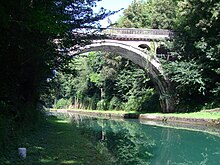Riqueval Bridge
The Riqueval Bridge (French: Pont de Riqueval, English Riqueval Bridge ) is a canal bridge in Picardy in the Aisne department . It is located exactly in the middle (approx. 2.5 km) between northern Bellicourt and southern Bellenglise and became known when it fell into the hands of the Allies in a coup d'état in the battle of the Saint-Quentin Canal on September 29, 1918 .
description
The Riqueval Bridge spans the Canal de Saint-Quentin 12 kilometers north of Saint-Quentin . Approx. 1.3 kilometers further north is the Riquevaltunnel , which runs the canal under the village of Bellicourt . The single-lane road bridge is around 30 meters long and is the former extension of the D 932 towards Vermand , which - less than 100 meters away - joins the N 44 . It was opened together with the canal in 1810. Today the bridge has the meaning of a farm road .
Combat operations on the bridge
On September 29, 1918 at 5:50 a.m., the Australian corps attacked, this time with the support of two American divisions from the American II Corps (the 27th and 30th US divisions), supported by about 150 tanks from the 4th and 5th Corps Panzer brigades were supported between Cambrai and Saint-Quentin (more precisely: between Bellicourt and Bellenglise ), as this was the interface between the 18th Army in the south and the 2nd Army . This approach was supported in the south by the French 1st Army and in the north by the 46th Division of the British Army. Despite this latent danger, the bridge has not yet been blown up because it was needed to supply the troops west of the canal. German pioneers had already attached explosive charges to the bridge. The canal and the tunnel were included in the heavily developed Siegfried Line, which, by the standards of the time, was difficult to conquer.
At the time of the attack, there was thick fog (which was probably also caused by smoke grenades by the attackers), which made the situation confusing for the defenders. Captain A. H. Charlton and the 6th Battalion of 137th Brigade North Stafford took advantage of the moment. With a small band that is said to have included nine men, he caught the guards by surprise and removed the explosives from the bridge. After signaled success, the 137th Brigade (belonging to the 46th Division) followed at 8:30 a.m. They overran the western positions and crossed the canal during the day. The German troops are said to have shown the lack of morale in the fight by the fact that the majority of the 2000 Germans are said to have preferred capture to escape. The famous photo of the Riqueval Bridge was taken on October 2nd, 1918. The bridge, which has hardly been changed since then, is still in operation today.
Trivia
In the English view of history, the conquest of the bridge is synonymous with the entry or breakthrough through the Siegfried position ; a turning point and end point of the war. King George V therefore visited the bridge and crossed it with Captain AH Charlton on December 2, 1918.
Ernst Jünger describes in his book: In steel thunderstorms not the bridge, but the farm not far from the bridge, as "Riqueval-Ferme". Today the homestead is located in the immediate vicinity of the Chain Ship Museum (Musée du Touage).
Individual evidence
- ^ Major Raymond E. Priestley, MC, RE: Breaking The Hindenburg Line, The Story of the 46th (North Midland) Division, London 1919
Web links
literature
- Major Raymond E. Priestley, MC, RE: Breaking The Hindenburg Line, The Story of the 46th (North Midland) Division, London 1919
- Mitchinson, KW: Battleground Europe Riqueval, South Yorkshire 1998
Coordinates: 49 ° 56 ′ 23.8 " N , 3 ° 14 ′ 31.6" E






